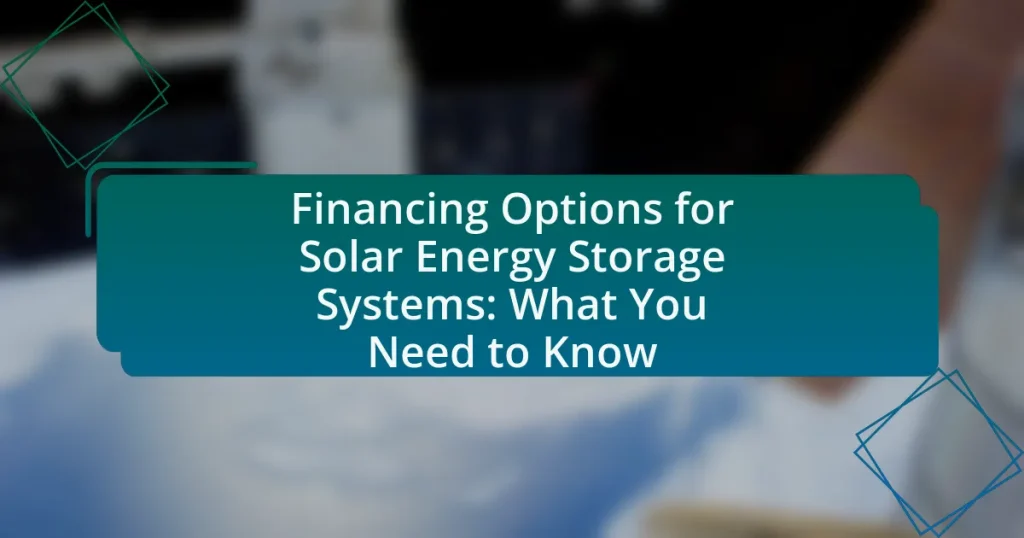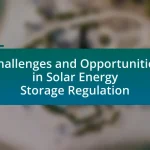The article focuses on financing options for solar energy storage systems, detailing various methods such as cash purchases, solar loans, leases, and power purchase agreements (PPAs). It examines the advantages and disadvantages of each financing option, including the impact of government incentives like the Federal Investment Tax Credit (ITC) on overall costs. Additionally, the article discusses factors to consider when choosing a financing option, the implications of installation costs, and the role of credit scores in securing favorable financing terms. By understanding these elements, consumers can make informed decisions to maximize the benefits of investing in solar energy storage systems.
What are the financing options for solar energy storage systems?
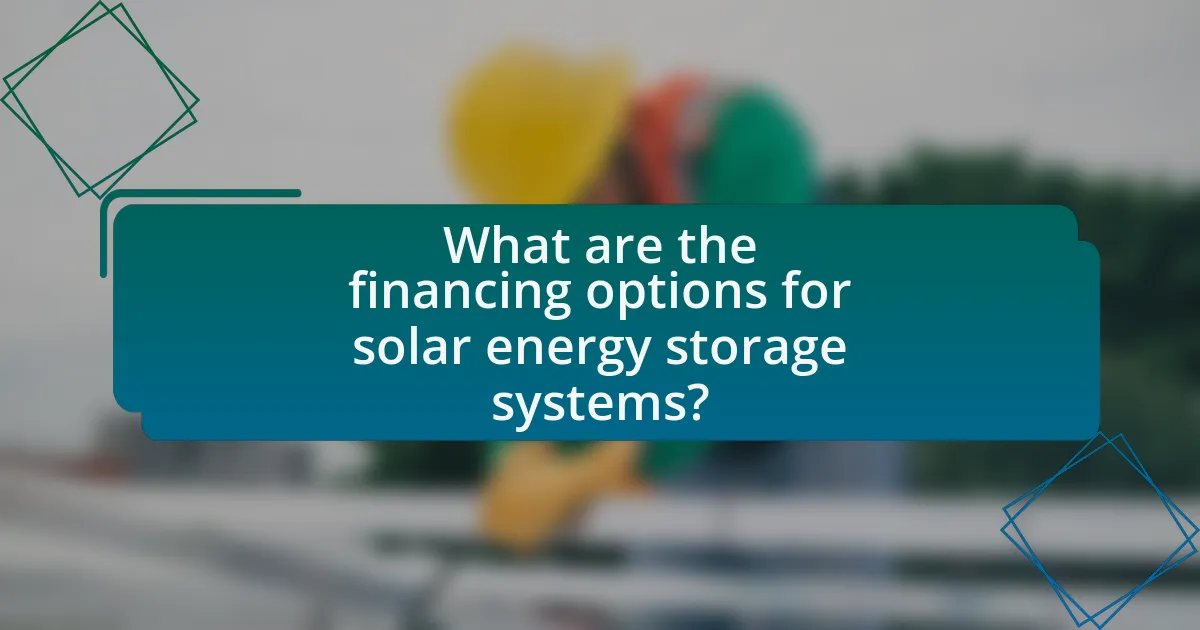

Financing options for solar energy storage systems include cash purchases, solar loans, leases, power purchase agreements (PPAs), and government incentives. Cash purchases allow for full ownership and immediate savings on energy costs, while solar loans enable consumers to finance the system over time, often with low-interest rates. Leases and PPAs provide access to solar energy without upfront costs, where a third party owns the system and the consumer pays for the energy produced. Additionally, government incentives such as tax credits and rebates can significantly reduce the overall cost of installation, making solar energy storage more accessible. For instance, the Federal Investment Tax Credit (ITC) allows homeowners to deduct a percentage of the cost of installing a solar energy system from their federal taxes, enhancing the financial viability of these systems.
How do different financing options compare for solar energy storage systems?
Different financing options for solar energy storage systems include cash purchases, loans, leases, and power purchase agreements (PPAs), each with distinct advantages and disadvantages. Cash purchases provide full ownership and immediate savings on energy bills but require a significant upfront investment. Loans allow for ownership while spreading costs over time, but they involve interest payments and potential debt. Leases offer lower initial costs and fixed monthly payments, yet they do not provide ownership benefits and may have escalated costs over time. PPAs enable users to pay for energy produced rather than the system itself, minimizing upfront costs, but they typically involve long-term contracts and may limit financial benefits from ownership. According to the National Renewable Energy Laboratory, the choice of financing can significantly impact the overall cost-effectiveness and return on investment of solar energy storage systems.
What are the advantages and disadvantages of cash purchases for solar energy storage systems?
Cash purchases for solar energy storage systems offer the advantage of immediate ownership and no ongoing financing costs, allowing buyers to avoid interest payments and potential debt. This upfront payment can lead to long-term savings, as the absence of financing fees means the total cost of ownership is lower over time. Additionally, cash purchases may qualify for certain tax incentives or rebates that are not available with financed options.
However, the disadvantages include the significant initial capital requirement, which can be a barrier for many consumers. Paying in cash also ties up liquid assets that could be used for other investments or emergencies, potentially impacting financial flexibility. Furthermore, without financing, buyers may miss out on opportunities to leverage low-interest loans or incentives that could make the overall investment more manageable.
How does financing through loans work for solar energy storage systems?
Financing through loans for solar energy storage systems allows consumers to borrow money to purchase and install these systems, typically repaying the loan over a set period with interest. This financing option enables homeowners and businesses to spread the cost of the solar energy storage system over time, making it more affordable upfront. Many lenders offer specific loan products designed for renewable energy projects, often with favorable terms such as lower interest rates or longer repayment periods. For instance, the average interest rate for solar loans can range from 4% to 8%, depending on the borrower’s creditworthiness and the lender’s policies. Additionally, some loan programs may offer incentives or rebates that can further reduce the overall cost of financing.
What are the implications of leasing solar energy storage systems?
Leasing solar energy storage systems can lead to reduced upfront costs and increased accessibility for consumers. This financing option allows users to benefit from solar energy without the significant initial investment required for purchasing systems outright. Additionally, leasing often includes maintenance and support services, which can alleviate concerns about system upkeep and performance. According to a report by the National Renewable Energy Laboratory, leasing can also facilitate quicker adoption of renewable technologies, as it lowers the financial barrier for entry, making solar energy more attainable for a broader audience.
What factors should you consider when choosing a financing option?
When choosing a financing option for solar energy storage systems, consider the total cost of ownership, including interest rates, fees, and repayment terms. These factors directly impact the overall financial burden and long-term savings associated with the investment. Additionally, evaluate the flexibility of the financing option, such as whether it allows for early repayment without penalties, as this can affect cash flow management. Assess the lender’s reputation and customer service, as reliable support can be crucial during the financing period. Finally, consider any available incentives or rebates that can reduce the effective cost of financing, as these can significantly enhance the financial viability of the solar energy storage system.
How do installation costs impact financing decisions for solar energy storage systems?
Installation costs significantly influence financing decisions for solar energy storage systems by determining the overall investment required and affecting the return on investment calculations. Higher installation costs can lead to increased financing needs, prompting potential buyers to seek loans, leases, or power purchase agreements to manage upfront expenses. For instance, if installation costs exceed $10,000, financing options may become essential to make the project financially viable, as many consumers prefer to spread payments over time rather than pay upfront. Additionally, lenders often assess installation costs when evaluating loan applications, as they impact the project’s cash flow and profitability, influencing interest rates and loan terms.
What role do government incentives play in financing solar energy storage systems?
Government incentives significantly enhance the financing of solar energy storage systems by reducing upfront costs and improving return on investment. These incentives, which can include tax credits, rebates, and grants, lower the financial barriers for consumers and businesses, making solar energy storage more accessible. For instance, the Federal Investment Tax Credit (ITC) allows for a 26% tax credit on the cost of solar systems, including storage, which directly decreases the initial expenditure. Additionally, state-level programs often provide further financial support, such as performance-based incentives, which reward users for the energy produced or stored. This financial backing not only stimulates market growth but also encourages the adoption of renewable energy technologies, contributing to broader environmental goals.
How does your credit score affect financing options for solar energy storage systems?
Your credit score significantly impacts financing options for solar energy storage systems by influencing the interest rates and loan terms available to you. Lenders assess credit scores to determine the risk of lending, with higher scores typically resulting in lower interest rates and more favorable loan conditions. For instance, individuals with credit scores above 700 may qualify for loans with interest rates as low as 3-5%, while those with scores below 600 might face rates exceeding 10%. This disparity can affect the overall cost of financing a solar energy storage system, making it crucial for potential buyers to understand their credit standing before seeking financing options.
What are the available incentives and rebates for solar energy storage systems?
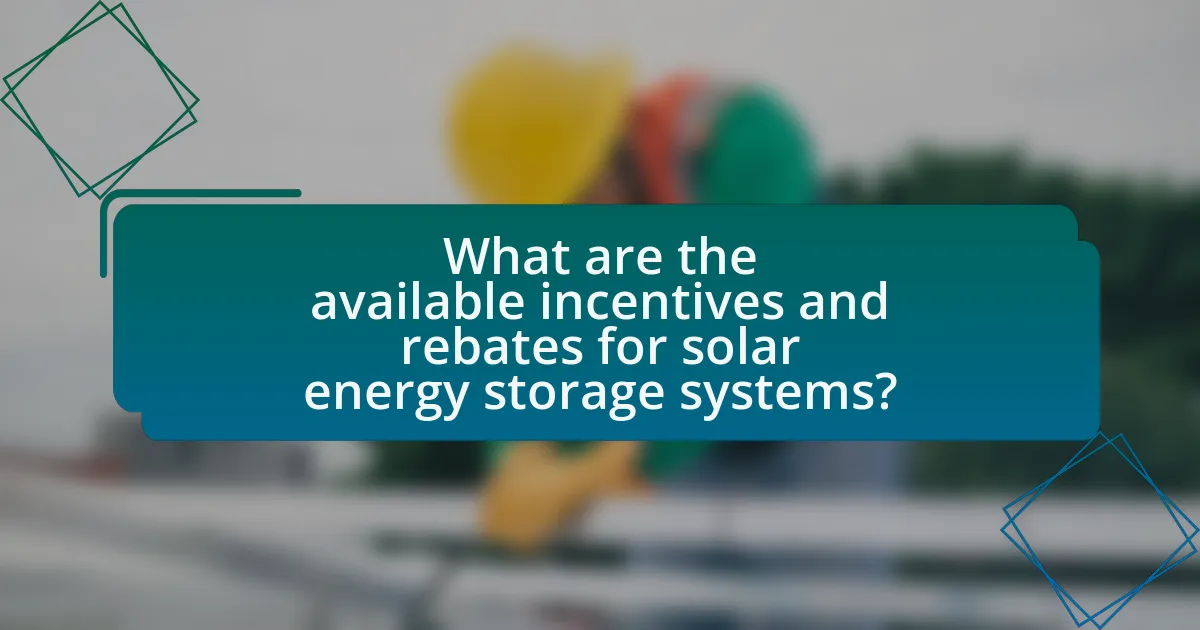

Available incentives and rebates for solar energy storage systems include federal tax credits, state-specific rebates, and utility incentives. The federal government offers a tax credit of 30% for solar energy systems, including storage, through the Investment Tax Credit (ITC), which is applicable until 2032. Many states provide additional rebates that can significantly reduce upfront costs; for example, California offers the Self-Generation Incentive Program (SGIP) which provides cash rebates for energy storage systems. Additionally, some utility companies offer incentives for customers who install solar energy storage systems, which can further lower the overall investment. These incentives are designed to promote the adoption of renewable energy technologies and can lead to substantial savings for homeowners and businesses.
How can federal and state incentives reduce the cost of solar energy storage systems?
Federal and state incentives can significantly reduce the cost of solar energy storage systems by providing financial support through tax credits, rebates, and grants. For instance, the federal Investment Tax Credit (ITC) allows homeowners and businesses to deduct a percentage of the cost of solar systems from their federal taxes, which can lower the upfront investment required for solar energy storage. Additionally, many states offer their own incentives, such as performance-based incentives or sales tax exemptions, which further decrease the overall cost. According to the Solar Energy Industries Association, these incentives can reduce the total cost of solar installations by 30% or more, making solar energy storage more accessible and affordable for consumers.
What specific federal tax credits are available for solar energy storage systems?
The specific federal tax credit available for solar energy storage systems is the Investment Tax Credit (ITC). The ITC allows homeowners and businesses to deduct a percentage of the cost of installing solar energy systems, including energy storage, from their federal taxes. As of 2023, the ITC provides a 30% tax credit for systems installed before the end of 2032, which applies to both solar panels and battery storage systems that are charged by solar energy. This credit has been a significant incentive for the adoption of solar technology, contributing to the growth of the solar energy market in the United States.
How do state-level incentives vary across different regions?
State-level incentives for solar energy storage systems vary significantly across different regions due to factors such as local policies, economic conditions, and energy needs. For instance, states like California offer robust incentives, including rebates and tax credits, to promote solar adoption, while states in the Midwest may provide fewer financial incentives due to lower solar penetration and different energy priorities. According to the Database of State Incentives for Renewables & Efficiency (DSIRE), California has implemented a variety of programs, including the Self-Generation Incentive Program, which allocates substantial funding for energy storage projects, whereas states like North Dakota have minimal incentives, reflecting their reliance on traditional energy sources. This regional disparity in incentives influences the adoption rates and financial viability of solar energy storage systems across the United States.
What are the eligibility requirements for solar energy storage incentives?
To qualify for solar energy storage incentives, applicants typically must own the solar energy system and the storage unit, and the system must be installed in a residential or commercial property. Additionally, the storage system often needs to meet specific technical standards, such as being certified by recognized testing laboratories. Many incentive programs also require that the installation be completed by a licensed contractor and that the system is interconnected to the grid. These requirements ensure that the systems are safe, effective, and compliant with local regulations.
How can homeowners qualify for solar energy storage rebates?
Homeowners can qualify for solar energy storage rebates by meeting specific eligibility criteria set by local, state, or federal programs. These criteria often include installing a qualifying solar energy storage system, using approved equipment, and sometimes demonstrating a commitment to energy efficiency. For example, the Federal Investment Tax Credit (ITC) allows homeowners to deduct a percentage of the cost of solar energy systems from their federal taxes, which can include energy storage systems if they are charged by solar power. Additionally, many states offer their own rebate programs that may require homeowners to apply through their utility companies or meet certain performance standards.
What documentation is needed to apply for solar energy storage incentives?
To apply for solar energy storage incentives, applicants typically need to provide proof of ownership of the solar energy system, installation receipts, and documentation of the energy storage system specifications. Additionally, applicants may be required to submit a completed application form specific to the incentive program, tax identification information, and any relevant utility interconnection agreements. These documents ensure that the application meets the eligibility criteria set by the incentive program, which often aims to promote the adoption of renewable energy technologies.
How can you maximize the benefits of financing solar energy storage systems?
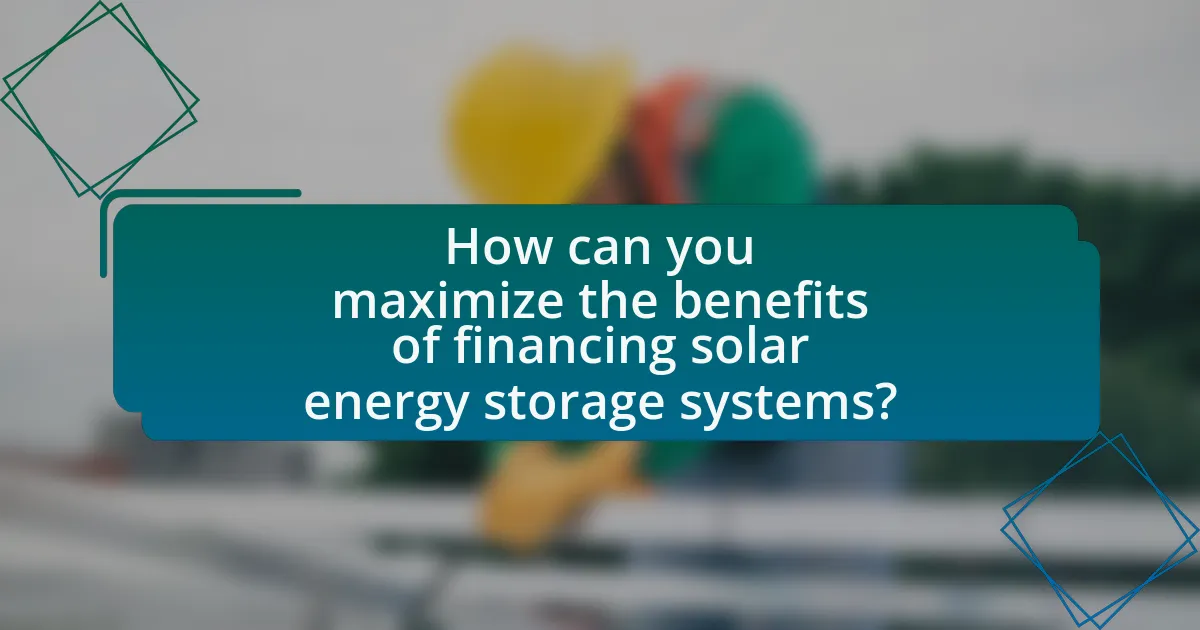

To maximize the benefits of financing solar energy storage systems, individuals and businesses should explore various financing options such as loans, leases, and power purchase agreements (PPAs). Utilizing loans can provide ownership benefits, including tax credits and incentives, while leases and PPAs can lower upfront costs and provide predictable monthly payments. Additionally, taking advantage of government incentives, such as the Investment Tax Credit (ITC), which allows for a significant percentage of the system cost to be deducted from federal taxes, can enhance financial returns. Research indicates that combining financing options with energy efficiency measures can further increase savings and system performance, making the investment more beneficial over time.
What strategies can help you choose the best financing option for your needs?
To choose the best financing option for solar energy storage systems, evaluate your financial situation, compare available financing products, and consider long-term savings versus upfront costs. Assessing your financial situation involves understanding your budget, credit score, and cash flow, which can influence loan terms and interest rates. Comparing financing products, such as loans, leases, and power purchase agreements, allows you to identify which option aligns with your financial goals and risk tolerance. Additionally, analyzing long-term savings from reduced energy bills against the initial investment helps determine the most cost-effective choice. According to the U.S. Department of Energy, homeowners can save significantly on energy costs with solar systems, making informed financing decisions crucial for maximizing these benefits.
How can you assess your long-term energy needs when financing solar energy storage systems?
To assess long-term energy needs when financing solar energy storage systems, start by analyzing your historical energy consumption data over the past year to identify patterns and peak usage times. This analysis helps in estimating future energy requirements based on lifestyle changes, such as increased appliance use or electric vehicle charging. Additionally, consider factors like local energy rates, potential energy efficiency improvements, and the expected lifespan of the solar storage system, which typically ranges from 10 to 15 years. By combining these elements, you can create a comprehensive projection of your energy needs, ensuring that the financing aligns with your long-term energy goals.
What are the best practices for managing financing agreements for solar energy storage systems?
The best practices for managing financing agreements for solar energy storage systems include thorough due diligence, clear documentation, and regular monitoring of financial performance. Conducting due diligence ensures that all parties understand the terms, risks, and benefits associated with the financing agreement. Clear documentation of all agreements, including payment schedules and responsibilities, minimizes misunderstandings and disputes. Regular monitoring of financial performance allows stakeholders to assess the effectiveness of the financing arrangement and make necessary adjustments. These practices are supported by industry standards that emphasize transparency and accountability in financial transactions related to renewable energy projects.
What common pitfalls should you avoid when financing solar energy storage systems?
When financing solar energy storage systems, common pitfalls to avoid include underestimating total costs, overlooking incentives, and failing to assess financing options thoroughly. Underestimating total costs can lead to budget shortfalls; for instance, installation, maintenance, and operational expenses can significantly increase the initial investment. Overlooking available incentives, such as tax credits or rebates, can result in missed savings opportunities; the Federal Investment Tax Credit offers a 26% tax credit for solar systems installed by the end of 2022. Lastly, failing to assess financing options thoroughly can lead to unfavorable loan terms; comparing interest rates and repayment plans is crucial to securing the best deal.
How can hidden fees impact your financing choice for solar energy storage systems?
Hidden fees can significantly affect your financing choice for solar energy storage systems by increasing the overall cost and reducing the perceived value of the investment. When evaluating financing options, consumers may overlook these fees, which can include installation charges, maintenance costs, or administrative fees, leading to a misleading understanding of the total financial commitment. For instance, a study by the National Renewable Energy Laboratory found that hidden fees can inflate the total cost of solar installations by up to 20%, which can deter potential buyers from pursuing financing options that initially seemed affordable. This discrepancy can ultimately influence decision-making, as consumers may opt for less favorable financing terms or abandon the investment altogether due to unexpected costs.
What should you watch out for in financing contracts for solar energy storage systems?
In financing contracts for solar energy storage systems, you should watch out for hidden fees and unclear terms. Hidden fees can significantly increase the overall cost of financing, while unclear terms may lead to misunderstandings regarding payment schedules, interest rates, and penalties for late payments. Additionally, it is crucial to scrutinize the warranty and maintenance obligations outlined in the contract, as these can impact the long-term viability and performance of the system. Understanding these elements ensures that you are fully aware of your financial commitments and the potential risks involved.
What practical tips can help you navigate financing for solar energy storage systems?
To navigate financing for solar energy storage systems effectively, consider exploring federal and state incentives, such as tax credits and rebates, which can significantly reduce upfront costs. For instance, the Federal Investment Tax Credit (ITC) allows homeowners to deduct a percentage of the cost of solar systems from their federal taxes, which can be as high as 26% through 2022. Additionally, research financing options like solar loans, which often have lower interest rates compared to traditional loans, and consider leasing options that may require little to no upfront payment. Engaging with local solar installers can provide insights into available financing programs tailored to your area, as many states offer specific incentives for energy storage systems. Lastly, reviewing your credit score can help you secure better financing terms, as lenders often consider creditworthiness when offering loans for solar energy projects.
